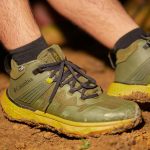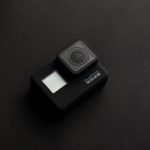Patagonia doesn’t use Gore-Tex in its apparel because it develops its own sustainable waterproof fabrics instead. You’ll find materials like the H2No® Performance Standard that deliver reliable waterproofing and breathability while focusing on eco-friendly production. Patagonia prioritizes recycled and bluesign®-approved fabrics to reduce environmental impact. Their waterproof gear balances durability with comfort, all without relying on Gore-Tex’s membrane technology. Keep exploring to see how Patagonia’s unique fabrics perform in wet weather.
Table of Contents
Key Takeaways
- Patagonia does not typically use Gore-Tex membranes in its apparel.
- Patagonia develops its own waterproof fabrics like the H2No® Performance Standard.
- The company emphasizes sustainable, recycled, and bluesign®-approved materials over Gore-Tex.
- Patagonia prioritizes eco-friendly waterproof technologies rather than relying on Gore-Tex products.
- Their waterproof apparel balances performance with environmental responsibility, distinct from Gore-Tex offerings.
Overview of Gore-Tex Technology
Although you may already know Gore-Tex as a popular waterproof fabric, its technology goes far beyond just keeping you dry.
When you wear Gore-Tex, you benefit from a unique membrane made of expanded polytetrafluoroethylene (ePTFE). This membrane blocks water droplets from entering while allowing water vapor from sweat to escape. That means you stay dry from rain and don’t feel clammy inside.
Gore-Tex’s ePTFE membrane keeps rain out while letting sweat vapor escape for lasting dryness and comfort.
Gore-Tex also features a durable water repellent (DWR) coating that causes water to bead up and roll off the surface, enhancing its performance. Plus, the fabric’s breathability and windproof properties make it ideal for various outdoor activities.
When you choose Gore-Tex, you’re getting a reliable barrier against the elements without sacrificing comfort or mobility.
Patagonia’s Approach to Waterproof Fabrics
Gore-Tex sets a high standard for waterproof and breathable fabrics, but Patagonia takes a distinct approach to waterproof apparel that reflects its commitment to sustainability and innovation.
When you choose Patagonia, you’ll notice:
- Eco-Friendly Materials: They prioritize recycled and bluesign®-approved fabrics to minimize environmental impact.
- Durability and Repairability: Their designs focus on long-lasting gear that you can easily repair, reducing waste.
- Innovative Waterproof Technologies: Instead of relying solely on Gore-Tex, Patagonia develops proprietary waterproof membranes and treatments, balancing performance with environmental responsibility.
You get waterproof gear that stands up to the elements while aligning with Patagonia’s mission to protect the planet.
Their approach proves you don’t have to sacrifice sustainability for high-performance outdoor apparel.
Key Materials Used by Patagonia
When you choose Patagonia, you’re opting for materials that combine performance with environmental responsibility. Patagonia uses recycled polyester and nylon extensively, reducing waste and reliance on virgin resources.
Their proprietary H2No® Performance Standard fabric offers durable waterproofing and breathability without harmful chemicals. You’ll also find Polartec® fleece made from recycled fibers for warmth and comfort.
For insulation, Patagonia often relies on 100% recycled down and synthetic alternatives like PrimaLoft® Eco, which provide warmth while minimizing environmental impact.
The company also emphasizes Fair Trade Certified™ sewing and bluesign® approved fabrics, ensuring ethical production and minimized ecological footprint.
Comparison Between Gore-Tex and Patagonia’s Fabrics
When choosing between Gore-Tex and Patagonia’s fabrics, you’ll notice Gore-Tex offers exceptional waterproofing and breathability.
Patagonia, on the other hand, focuses on sustainable materials with innovative fabric technologies tailored for performance and environmental impact.
Let’s compare how each brand’s materials handle durability, comfort, and eco-friendliness.
Gore-Tex Material Features
Waterproofing and breathability define the core of high-performance outdoor fabrics, and comparing Gore-Tex with Patagonia’s materials reveals distinct approaches to these features.
Gore-Tex stands out for its unique membrane structure that blocks water while allowing vapor to escape, making it highly reliable in wet conditions.
When you choose Gore-Tex, you get:
- Guaranteed Waterproofing – Its membrane guarantees no water penetration, even in heavy rain.
- Exceptional Breathability – The microporous membrane lets sweat vapor out, keeping you dry inside.
- Durability – Gore-Tex fabrics resist abrasion and maintain performance over time.
While Patagonia offers innovative alternatives, Gore-Tex remains a benchmark in waterproof-breathable fabric technology, especially if you prioritize consistent protection during intense outdoor activities.
Patagonia Fabric Technologies
Gore-Tex sets a high standard for waterproof and breathable fabrics, but Patagonia brings its own innovations to the table that might better suit your needs. Patagonia focuses on sustainability with fabrics like H2No® and Gore-Tex alternatives that offer reliable waterproofing while reducing environmental impact. You’ll find Patagonia’s materials often emphasize durability and eco-conscious manufacturing without compromising performance.
| Feature | Gore-Tex | Patagonia Fabrics |
|---|---|---|
| Waterproofing | Membrane technology | H2No® and others |
| Sustainability | Limited eco initiatives | Strong focus on eco-friendly methods |
| Durability | High | High with added environmental care |
Choosing between them depends on what matters most to you—performance or sustainability.
Benefits of Patagonia’s Waterproof Technologies
Although you mightn’t always notice it, Patagonia’s waterproof technologies keep you dry and comfortable in harsh weather by combining advanced materials with thoughtful design.
Patagonia’s waterproof tech blends advanced materials and smart design to keep you dry and comfortable outdoors.
When you wear their gear, you benefit from:
- Reliable Water Resistance – The fabrics repel water effectively, so you stay dry even in heavy rain.
- Breathability – Moisture from sweat escapes easily, preventing clamminess and overheating during activity.
- Durability – These materials withstand abrasion and repeated use, maintaining performance over time.
Choosing the Right Patagonia Gear for Wet Weather
When you face wet weather, picking the right Patagonia gear can make all the difference in staying comfortable and dry.
Start by choosing jackets with H2No® Performance Standard, Patagonia’s proprietary waterproof and breathable fabric technology. These jackets repel water while allowing moisture to escape, keeping you dry inside. Look for models like the Torrentshell or the Calcite Jacket, designed specifically for rain protection.
Layering is key—pair your waterproof shell with moisture-wicking base layers to manage sweat effectively. Avoid cotton, which traps moisture and chills you.
For pants, consider Patagonia’s waterproof rain pants that offer full coverage without bulk. By selecting gear tailored for wet conditions, you’ll stay protected and focused, no matter how hard the rain falls.
Frequently Asked Questions
How Does Patagonia’S Environmental Policy Impact Its Fabric Choices?
You’ll find Patagonia’s environmental policy drives them to choose sustainable, recycled, and bluesign®-approved fabrics. They prioritize low-impact materials to reduce waste and pollution, ensuring their gear aligns with their strong commitment to protecting the planet.
Are Patagonia’S Waterproof Jackets Suitable for Extreme Winter Sports?
You might wonder if Patagonia’s waterproof jackets handle extreme winter sports well. They do—they use durable, breathable fabrics with reliable water resistance, but for the harshest conditions, you might want specialized gear tailored to your specific needs.
Does Patagonia Offer Repair Services for Damaged Waterproof Gear?
Yes, Patagonia offers repair services for your damaged waterproof gear through their Worn Wear program. You can send in your items, and they’ll fix them, helping you extend the life of your favorite outdoor apparel.
How Long Do Patagonia’S Waterproof Fabrics Typically Last?
You’ll feel like your Patagonia jacket lasts forever—often several years—thanks to their tough, waterproof fabrics. With proper care, it’ll keep you dry and comfy through countless adventures, resisting wear like a champion.
Is Patagonia’S Waterproof Gear Ethically Manufactured?
You can trust Patagonia’s waterproof gear is ethically manufactured. They focus on fair labor practices, environmental responsibility, and transparency throughout their supply chain, ensuring you get high-quality products made with strong ethical standards.
- Where to Buy Sherpa Suede Fabric - July 12, 2025
- How to Draw or Illustrate the Texture of Suede Fabric - July 12, 2025
- What Is Baseball Suede Leather Fabric? - July 12, 2025







